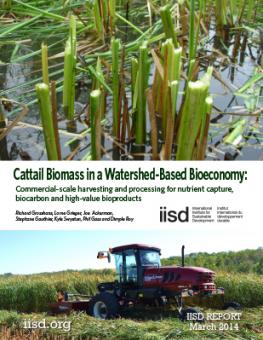
Cattail Biomass in a Watershed-Based Bioeconomy: Commercial-scale harvesting and processing for nutrient capture, biocarbon and high-value bioproducts
One of the fundamental insights of the Watershed-Bioeconomy research is that phosphorus, the nutrient responsible for fouling Lake Winnipeg and other aquatic ecosystems, is also a scarce and valuable natural resource that is critical to agricultural production and global food security.
Previous IISD research introduced the concept of harvesting “ecological biomass”—primarily a large aquatic plant species cattail (Typha spp.) —for watershed nutrient management and biomass for industry. Harvesting the cattail removes the nutrients (i.e., phosphorus) that are taken up during growth and stored within the harvested plant material. This biomass can then be utilized as a solid fuel for bioenergy, biocarbon and higher-value biofuels and bioproducts.
Current work moves these research concepts to pilot and commercial-scale applications. Cattail and other ecological biomass species are harvested on marginal agricultural land—in stormwater ditches and from shallow water retention storage sites, areas that naturally concentrate nutrients from runoff water. Two years of commercial pilot harvests were conducted at Pelly’s Lake near Holland, Manitoba, in the LaSalle Redboine Conservation District. Cattail harvest research in 2013 focused on optimizing methods, logistics and equipment for cutting, baling and collection. Solid fuel products were produced from harvested cattail biomass and mixed with wheat straw for a high-value solid fuel product, which was used in biomass stoker boiler systems for heat production. Cattail was also assessed as a feedstock for biocarbon or biochar. A comparison of cattail biochar was conducted to wheat straw biochar, evaluating energy content and various parameters from production. Cattail ash from solid fuel combustion trials and cattail biochar were analyzed for agricultural and soil values, and preliminary testing was performed on cattail biochar as an activated carbon medium for water filtration.
IISDs research on innovative watershed management solutions has proven that cattail is a sustainable and renewable source of biomass that provides multiple environmental and economic co-benefits when harvested as part of a nutrient and water retention management strategy. The difficult challenge of reducing non-point nutrient loading to Lake Winnipeg can be addressed, while providing economic revenue within a watershed-based bioeconomy.
You might also be interested in
Large Area Planning in the Nelson-Churchill River Basin (NCRB): Laying a foundation in northern Manitoba
This report explores two trends—the growing tendency towards large basin management and consideration of ecosystem services in decision making—for the northern portion of the Nelson-Churchill River Basin in Canada.
Large Area Planning in the Nelson-Churchill River Basin (NCRB): Laying a foundation in northern Manitoba (Summary)
This document summarizes a longer report that explores two trends—the growing tendency towards large basin management and consideration of ecosystem services in decision making—for the northern portion of the Nelson-Churchill River Basin in Canada.